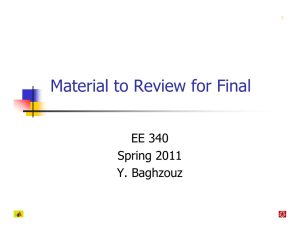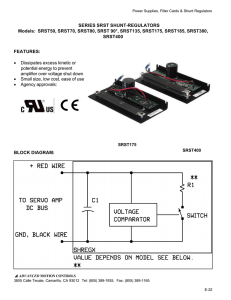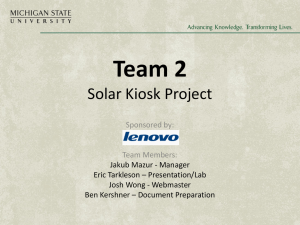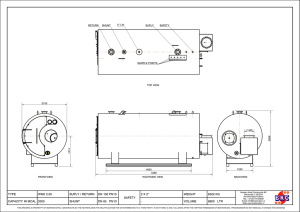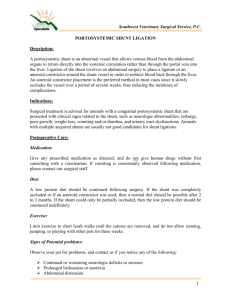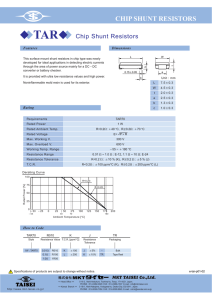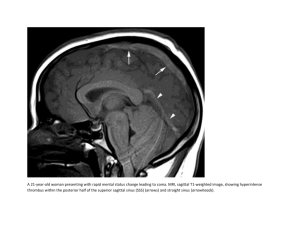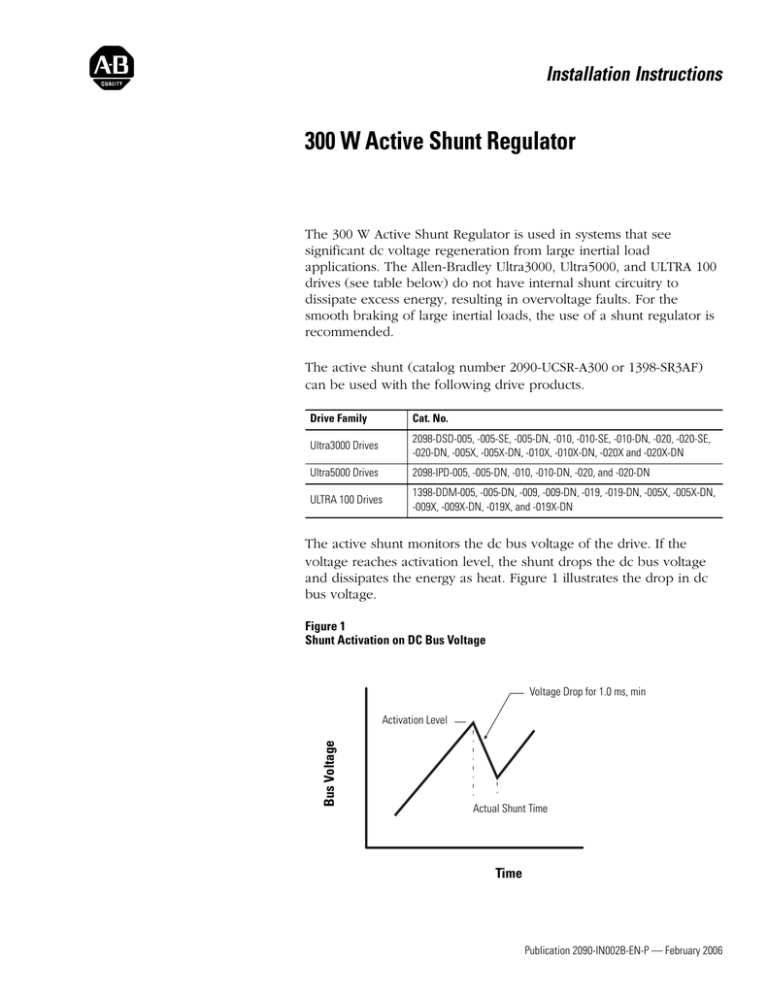
Installation Instructions
300 W Active Shunt Regulator
The 300 W Active Shunt Regulator is used in systems that see
significant dc voltage regeneration from large inertial load
applications. The Allen-Bradley Ultra3000, Ultra5000, and ULTRA 100
drives (see table below) do not have internal shunt circuitry to
dissipate excess energy, resulting in overvoltage faults. For the
smooth braking of large inertial loads, the use of a shunt regulator is
recommended.
The active shunt (catalog number 2090-UCSR-A300 or 1398-SR3AF)
can be used with the following drive products.
Drive Family
Cat. No.
Ultra3000 Drives
2098-DSD-005, -005-SE, -005-DN, -010, -010-SE, -010-DN, -020, -020-SE,
-020-DN, -005X, -005X-DN, -010X, -010X-DN, -020X and -020X-DN
Ultra5000 Drives
2098-IPD-005, -005-DN, -010, -010-DN, -020, and -020-DN
ULTRA 100 Drives
1398-DDM-005, -005-DN, -009, -009-DN, -019, -019-DN, -005X, -005X-DN,
-009X, -009X-DN, -019X, and -019X-DN
The active shunt monitors the dc bus voltage of the drive. If the
voltage reaches activation level, the shunt drops the dc bus voltage
and dissipates the energy as heat. Figure 1 illustrates the drop in dc
bus voltage.
Figure 1
Shunt Activation on DC Bus Voltage
Voltage Drop for 1.0 ms, min
Bus Voltage
Activation Level
Actual Shunt Time
Time
1
Publication 2090-IN002B-EN-P — February 2006
2
300 W Active Shunt Regulator
The peak shunting capability is a direct result of using a 36 Ω shunt
resistor. The peak shunt power can be calculated by dividing bus
voltage squared, by 36. For example, if the bus voltage is 380V when
the shunt is energized, the shunt power is 4,011 W.
Performance
380V
36 Ω
2
4011 W
Continuous Shunt Capability
A shunt regeneration profile is defined by shunt time, cycle time, and
peak power level. Figure 2 illustrates a profile of regeneration during
a machine cycle.
•
Shunt power is the peak shunt power during the shunt time.
•
Shunt time is the time the power pulse is dissipated by the shunt.
•
Cycle time is the time from the beginning of one shunt time to the
beginning of the next shunt time.
Figure 2
Shunt Regeneration Profile
Area = Shunt Energy (joules)
Shunt Power
(watts)
Shunt Time
(seconds)
Cycle Time or
Machine Cycle
Publication 2090-IN002B-EN-P — February 2006
300 W Active Shunt Regulator
3
If the required average shunt power over the machine cycle is ≤300 W
and the cycle time is ≤300 seconds, the active shunt can handle the
application. Figure 3 illustrates the capability of an active shunt at
40 ºC (104 ºF) ambient temperature. The different lines represent
different cycle times (rates). The x-axis is the shunt power during the
shunt time and the y-axis is the maximum shunt time for that power
and cycle time. For example, the bottom line is a 5 second cycle time
(meaning the shunt pulse comes every 5 seconds) and it intersects the
800 W pulse for 2 seconds every five seconds in a 40 ºC (104 ºF) or
less environment. This means that the shunt can handle an 800 W
pulse lasting for two seconds, every 5 seconds if the ambient
temperature is not above 40 ºC (104 ºF).
IMPORTANT
The limiting factor on how much average power can
be dissipated is temperature. The shunt power
capability increases approximately 5.5 W for every
1.0 ºC drop in ambient temperature (3.1 W/ ºF).
Increasing the air flow across the heat sink can
increase the continuous shunt capability significantly,
although obstructing air flow can decrease it
significantly.
Figure 3
Active Shunt Module Thermal Capacity
Pulse Time versus Pulse Power
Different Cycle Times for the Active Shunt
Shunt Time (seconds)
Lower left of lines is safe, upper right is unsafe.
Graph assumes 40 ºC (104 ºF) ambient.
Shunt Cycle Times
One-Shot
5 Minute Cycle
2 Minute Cycle
(showing seconds)
30 Second Cycle
5 Second Cycle
Shunt Power (watts)
Publication 2090-IN002B-EN-P — February 2006
4
300 W Active Shunt Regulator
Install the Shunt
Refer to Figure 4 for shunt module spacing requirements.
Adjust
Do not mount shunt
module on its side.
Do not mount temperature
sensitive components above
the shunt module.
Overtemp
DC Bus
Active
Active Shunt
Figure 4
Shunt Module Spacing Requirements within an Enclosure
UltraSeries
Allen Bradley
5 mm (2 in.) min clearance
above the shunt module.
2.5 mm (1.0 in.) min clearance
in front of the shunt module.
UltraSeries
Allen Bradley
Active Shunt
Adjust
Overtemp
DC Bus
Active
1.25 mm (0.5 in.) min clearance on
each side of the shunt module.
1.25 mm (0.5 in.) min clearance on
each side of the shunt module.
5 mm (2 in.) min clearance
below the shunt module.
ATTENTION
The shunt module can release a large amount of heat
over time.
Any materials above the shunt module or its
enclosure may need the protection of a metal plate
to keep from deteriorating.
Failure to observe this precaution could result in
damage to surrounding materials, possibly leading to
fire.
ATTENTION
The shunt module can release a large amount of heat
inside an enclosure.
Be sure there is enough ventilation so as the
maximum ambient temperature of 40 °C (104 °F) is
not exceeded. Power performance must be
decreased 5.5 W for every 1.0 °C (3.1 °F) of
increasing ambient temperature.
Failure to observe this precaution could result in
damage to the shunt module.
Publication 2090-IN002B-EN-P — February 2006
300 W Active Shunt Regulator
5
If the work environment dictates, the shunt module should be in an
enclosure providing protection against dust and splashing water
(IP54), or dust free and protection against water jets (IP65).
ATTENTION
Avoid contaminating electronic components.
Provide a quality air source to cabinets: free of
debris, oil, corrosives, or electrically conductive
contaminates. All cabinets should have scheduled
inspections and be cleaned as needed.
Failure to observe these safety procedures could
result in breakdown and damage to equipment.
Many National Electrical Manufacturers Association (NEMA) Type 4
cabinets provide this level of protection.
ATTENTION
If you mount the shunt module inside a cabinet, you
must make sure that the ambient temperature inside
the cabinet does not exceed 40 °C (104 °F). Power
performance must be decreased 5.5 W for every
1.0 °C (3.1 °F) of increasing ambient temperature.
Mount the Active Shunt Module
To mount the shunt module on a flat, solid, grounded surface:
1. Install the top mounting fasteners on the subpanel for the shunt
module.
Refer to Product Specifications on page 7 for fastener, wire, and
terminal torque specifications.
2. Mount the shunt module on the two fasteners.
3. Install the lower fasteners.
4. Tighten all mounting fasteners.
Publication 2090-IN002B-EN-P — February 2006
6
300 W Active Shunt Regulator
Wire the Active Shunt Module to a Drive
It is recommended to use shielded, high temperature (75 °C, 600V),
4.0 to 2.5 mm2 (12 to 14 AWG) copper wire, or run the wire through
shielded conduit. The maximum length of each wire should be 3.05 m
(10 ft) with the shield grounded at both ends. Unshielded wiring
should be kept as short as possible.
1. Locate the terminal block on your active shunt.
2. Wire the +DC Bus connection to the positive (+) bus connection
of the drive, and the -DC Bus connection to the negative (-) bus
connection of the drive.
IMPORTANT
The dc bus connections should only be used to
connect a single drive to the active shunt module.
Contact your Allen-Bradley representative for further
assistance if your application requires additional dc
power connections.
3. Wire the AC Line Detect to the respective terminals (L1, L2/N) of
the drive or its ac power source.
The shunt module will actively sense when ac power is lost to the
drive and after 0.25/s, it will drop the dc bus.
4. Wire the Chassis ground to earth ground.
5. Tighten the terminal block screws to 1.2 Nm (11 lb-in).
6. Gently pull on each wire to make sure it does not release from its
terminal.
7. Reinsert and tighten any loose wires.
Publication 2090-IN002B-EN-P — February 2006
300 W Active Shunt Regulator
Product Specifications
7
Specifications for the active shunt module are provided in the
following tables. Physical measurements are shown in 300 W Active
Shunt Regulator Mounting Dimensions on page 8.
General Specifications
Value
Weight
1.51 kg (3.34 lb)
Vibration
2 g at 10...2000 Hz
Shock
15 g 11 ms half sine
Altitude
1500 m (5000 ft)
Humidity
5...95% noncondensing
Ambient operating temperature (1)
0...40 °C (32...104 °F)
Air flow clearances
50 mm (2.0 in.) above and below unit for air flow
(1)
Power performance increases/decreases approximately 5.5 W for every 1.0 °C (3.1 W/ °F) drop/rise in ambient
temperature.
Mounting Hardware
Size
Metal screws
#10
Hex cap screws
1/4 in.-20
Hex cap screws (metric)
M5
Wiring
Size
75 °C copper wire
4.0 mm2 (12 AWG) or
2.5 mm2 (14 AWG)
Terminal Block Screws
Torque
Chrome plated brass
1.2 Nm (11 lb-in)
Publication 2090-IN002B-EN-P — February 2006
8
300 W Active Shunt Regulator
Figure 5
300 W Active Shunt Regulator Mounting Dimensions
65.1
(2.5)
13.21
(0.5)
38.1
(1.5)
18.6
(0.7)
6.35
(0.25)
Clearance holes for #10 (M5) screws.
129
(5.0)
UltraSeries
Allen Bradley
Active Shunt
Adjust
Overtemp
DC Bus
Active
Dimensions are in mm (in.)
186.7
(7.3)
198
(7.8)
97.3
(3.8)
5.6
(0.22)
Publication 2090-IN002B-EN-P — February 2006
143
(5.6)
300 W Active Shunt Regulator
ULTRA 100 Radiated
Emissions CE Compliance
9
In order for the ULTRA 100 drive to comply with the CE radiated
emissions standards, ferrites must be added to the ends of the twisted
dc bus wires when using an active shunt. Route both wires through
the ferrites. Ferrites with an impedance at 100 MHz between 100 to
200 Ω were found to be effective. The following table lists some
readily available ferrites with effective impedance ratings.
Ferrites for CE Radiated Emissions Compliance
Mfg. Part/No.
D
E
Impedance
SS28B2034
0.250
0.120
125 Ω
SS28B2037
0.350
0.200
154 Ω
SS28B2032
0.500
0.200
230 Ω
Box-shaped ferrite assembly in fully enclosed
nylon case. End ports are surrounded with
flexible spring flutes to grip a range of cable
diameters from 3.2...12.7 mm (0.125...0.500 in.).
FerriShield, Inc.
350 Fifth Avenue, Suite 7310
New York, NY 10118-7591
Figure 6
DC Bus Wiring Layout Using Ferrites with Shielded Cable
UltraSeries
Allen Bradley
Active Shunt
2
2
Adjust
Overtemp
DC Bus
Active
•
•
•
Place shunt in metal enclosure providing EMI noise
reduction.
For ULTRA 100 drive only:
Install a 100 to 200 W ferrite RFI suppressor at both ends
of the dc bus wires to comply with CE radiated
emissions standard.
Some drive terminals are marked R, S, and T instead of
U, V, and W.
Publication 2090-IN002B-EN-P — February 2006
10
300 W Active Shunt Regulator
Maintain the Active Shunt
Figure 7 shows information relating to the adjust screw and the LEDs
that show shunt activity. Refer to Troubleshoot on page 11 for more
information.
Figure 7
Shunt Module Adjustment Screw and LEDs
Active Shunt
Adjust
Overtemp
DC Bus
Active
Adjust (screw)
The Adjust screw sets the activation level of the shunt. It is set at
the factory and ordinarily will not need adjustment.
Overtemp (LED)
The Overtemp (yellow) LED illuminates when the unit’s thermostat
has tripped. While the thermostat is tripped, the unit will not shunt
excess voltage (but the dc bus drop feature will still function) and
this will usually cause the host drive to fault on overvoltage. Once
this LED turns on, power must be removed before it will shut off,
even if the active shunt unit has cooled and is functioning again.
DC Bus (LED)
The DC Bus (green) LED illuminates when there is sufficient bus
voltage. The higher the bus voltage, the brighter the LED will glow.
Active (LED)
The Active (green) LED illuminates while the shunt is dissipating
power. This LED indicates not only that the shunt is functioning, but
shows how often the shunt is energized.
Publication 2090-IN002B-EN-P — February 2006
300 W Active Shunt Regulator
11
Troubleshoot
Active Shunt
If this fault appears
Then
Overtemp light is on
The internal thermostat in the shunt unit is
getting too hot. To fix this problem:
•
reduce the average shunt power,
•
reduce the ambient temperature of the air
around the shunt, or
•
increase the amount of air passing over the
heat-sink fins.
Once this LED turns on, only removing power will
shut it off; even when the active shunt unit has
cooled and is functioning again.
Drive registers Bus Overvoltage faults, but the
active shunt is functioning and the Overtemp light
is off.
There are two situations where this can happen.
•
First, if the Bus Overvoltage trip level on the
drive is too low. Since this is not adjustable
on the drive, the solution is to reduce the
turn-on threshold level of the active shunt.
This is done by turning the Adjust pot
counter-clockwise.
•
Second, if the regeneration power exceeds
the shunt power for too long. It is possible
for the drive to generate more power than
the active shunt can handle. There are two
possible solutions to this situation.
•
Adjust the regeneration profile so that
the drive generates less power for a
longer time. The drive current limit
parameters may be useful here.
•
Reduce the turn-on threshold level of
the active shunt, which turns on the
shunt earlier in the regeneration
profile.
Adjust
Overtemp
DC Bus
Active
Publication 2090-IN002B-EN-P — February 2006
Rockwell Automation
Support
Rockwell Automation provides technical information on the web to assist you
in using its products. At http://support.rockwellautomation.com, you can find
technical manuals, a knowledge base of FAQs, technical and application
notes, sample code and links to software service packs, and a MySupport
feature that you can customize to make the best use of these tools.
For an additional level of technical phone support for installation,
configuration and troubleshooting, we offer TechConnect Support programs.
For more information, contact your local distributor or Rockwell Automation
representative, or visit http://support.rockwellautomation.com.
Installation Assistance
If you experience a problem with a hardware module within the first 24
hours of installation, please review the information that's contained in this
manual. You can also contact a special Customer Support number for initial
help in getting your module up and running:
United States
1.440.646.3223
Monday – Friday, 8am – 5pm EST
Outside United
States
Please contact your local Rockwell Automation representative for any
technical support issues.
New Product Satisfaction Return
Rockwell tests all of its products to ensure that they are fully operational
when shipped from the manufacturing facility. However, if your product is
not functioning and needs to be returned:
United States
Contact your distributor. You must provide a Customer Support case number
(see phone number above to obtain one) to your distributor in order to
complete the return process.
Outside United
States
Please contact your local Rockwell Automation representative for return
procedure.
Allen-Bradley, Ultra3000, Ultra5000, ULTRA 100, and Rockwell Automation are trademarks of Rockwell
Automation, Inc. Trademarks not belonging to Rockwell Automation are property of their respective
companies.
Publication 2090-IN002B-EN-P — February 200612
Supersedes Publication 2090-IN002A-EN-P — March 2001
PN 0013-1091-002
Copyright © 2006 Rockwell Automation, Inc. All rights reserved. Printed in the U.S.A.

